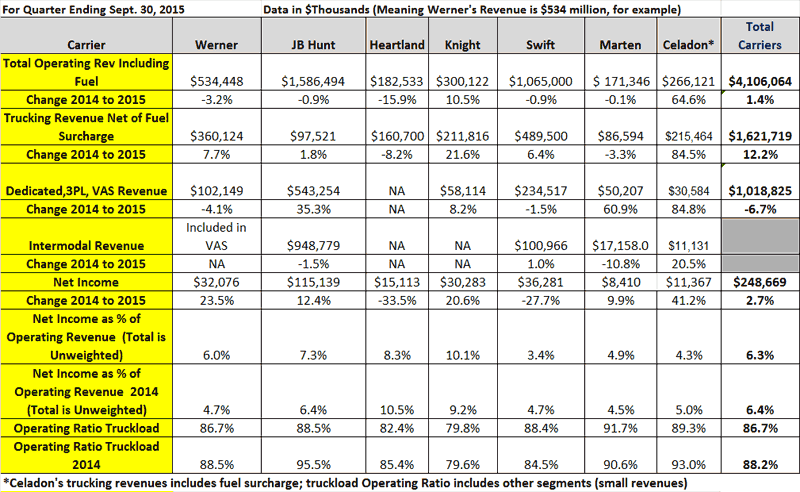From SCDigest's On-Target E-Magazine
- Nov.11, 2015 -
Supply Chain News: US Truckload Carriers Enjoy Generally Strong Q3, Finally Starting to Add Capacity
A Detailed Look at Truckload Segment Results and Trends in Q3
SCDigest Editorial Staff
US truckload carriers decent if somewhat mixed results in Q3, with most citing slowing demand even as they modestly moved to add capacity.
SCDigest Says: |

Overall profitability stayed about the same, at 6.3% of revenues versus 6.4% in 2014, though again those revenues were impacted by falling fuel surcharges, so the actual profit picture was actually improved over last year. |
| |
|
What Do You Say?
|
|
|
|
We're back as usual with our quarterly review of the results and trends across freight modes.
This week, we cover the US truckload sector and then follow in the next two weeks with reviews of first the rail and then the LTL carriers after that.
In looking at the truckload market overall in Q3, rates were up fairly strongly, though well down from earlier in the year. The Cass Linehaul Index, which measures per mile truckload rates before accessorials, was up 3.6%, 3.7% and 3.2% in July, August and September, respectively, versus 2014 levels.
That compares with rate gains of more than 5% in each of the first three months of 2015.
Average revenues per total mile net of fuel surcharge, a proxy for rate changes, increased 2.8% at Werner in Q3 compared to the same period in 2014. JB Hunt did even better, saying rates in its truckload unit were up 4.5% year over year Q3. Knight said its revenue per loaded mile was up 4.6% in the quarter.
The freight analysts at Avondale Partners, who work with Cass on the Index, recently lowered their predictions for full year rate gains of 3.5% to 5.5%, several percentage points down from earlier in the year, noting that several factors have together contributed to an increase in overall capacity.
These 3-4.5% increase in rates in Q3 were realized by almost every one of those public carriers we follow even though virtually all of them used adjectives such as "tepid" or "lukewarm," to describe the freight market in the quarter. Werner, for example, noted that "freight demand in Q3 and through October has been similar to historical standards and not as strong as the robust freight market during the same periods in 2014."
As another data point, the American Trucking Associations' seasonally adjusted Freight Tonnage Index was up 3.3% year to date through September.
"The see-saw pattern in truck freight tonnage continued again in September, except that the gain didn't fully wipe out August's decline" said ATA Chief Economist Bob Costello. "However, over the last few months tonnage has snapped back from softness this past spring and early summer, and is approaching the record high."
But despite some recent softness, the carriers are starting to add back some capacity, even in the face of the continued driver shortage which constrains fleet growth. JB Hunt's truckload unit, for example, which lowered its tractor count for quarter after quarter in recent years, ended Q3 with 2,100 tractors compared to 1,843 a year ago.
Swift said its average operational truck count across all segments increased by 831, or 4.8%, year over year in the third quarter, including a 517 increase from the beginning of 2015 through September 30, 2015.
So, after years of fleet discipline that saw limited fleet growth, the trend seems to heading modestly the other way. That said, Werner noted that "Truckload industry capacity is challenged by an extremely competitive driver recruiting market and heightened regulatory cost increases for safety and truck ownership. We expect this favorable trend [for carriers] will continue."
Carrier revenues for the quarter and year to date have been impacted heavily by the reduction in fuel surcharge revenues stemming from the big drop in diesel prices. That of course doesn't really impact the underlying carrier financials, as the fuel surcharge is largely just a cost pass through, although with some lag such that it can impact results in a given quarter.
One noticeable change is that the rapid growth in intermodal clearly slowed at many carriers in Q3. JB Hunt's intermodal unit, which saw near double digit growth for many years, saw volume growth of just 3% in Q3. Swift saw intermodal growth of just 1% in the quarter, amidst evidence low diesel prices were causing some freight to move from rail to truck in recent months.
Profits across all seven truckload carriers we follow were up a modest 2.7% for the quarter, though as shown in the chart below, that overall number masks some large swings across individual carriers. Profits were up more than 23% at Werner, for example, but down 33% at Heartland Express.
Overall profitability stayed about the same, at 6.3% of revenues versus 6.4% in 2014, though again those revenues were impacted by falling fuel surcharges, so the actual profit picture was actually improved over last year.
That was reflected in improved average operating ratios, or operating expense divided by operating revenue, a key transport sector metric. Our unweighted average across all seven carriers fell to 86.7%, versus 88.2% in 2014.
The full Q3 results for all seven carriers is provided in the table below.
Truckload Results Q3 2015

Source: SCDigest
Click here to View Larger Image
(Transportation Management Article Continued Below)
|